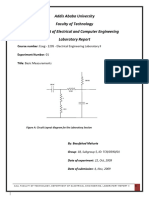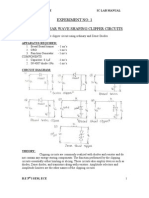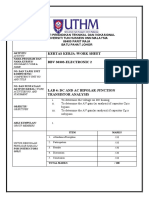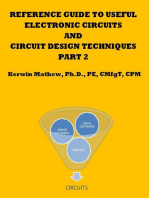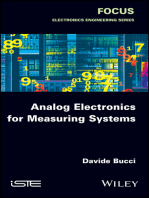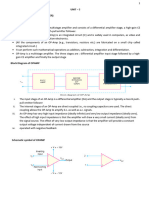Lab Report 6
Uploaded by
ung65014Lab Report 6
Uploaded by
ung65014Addis Ababa University
Faculty of Technology
Department of Electrical and Computer Engineering
Laboratory Report
Course number: Eceg: - 2205 - Electrical Engineering Laboratory II
Experiment Number: 06
Title: Transistor Biasing and Operating point Stabilization
µ VC
IB V2
VB
V1
RB VCC
VBB
IE
Figure A: Circuit Diagram for the Lab. Session
By: Besufekad Mekuria
Group: 1B, Subgroup 5, ID: TCR/0590/01
Date of Lab. session: December 16, 2009
Date of submission: December 23, 2009
AAU, FACULTY OF TECHNOLOGY, DEPARTMENT OF ELECTRICAL 0
ENGINEERING, LABORATORY II REPORT
TABLE OF CONTENTS:
Section Sub-Title Location
NO
1.1 Introduction Page Two
1.2 Objective Page Two
1.3 Preparation Page Three
1.4 Used Equipment Page Three
1.5 Components used Page Three
1.6 Theory Page Three
1.7 Calculations Page Four
1.8 Procedure Page Five
1.9 Results Page Five
1.10 Conclusion Page Seven
AAU, FACULTY OF TECHNOLOGY, DEPARTMENT OF ELECTRICAL 1
ENGINEERING, LABORATORY II REPORT
Transistor Biasing and Operating point Stabilization
1.1 INTRODUCTION
Determining the properties of a transistor for which it operates at the optimal
circumstances is very important in describing many practically useful circuits like:
Amplifier circuits like Differential and operational Amplifier circuits, therefore, normal
moderate operation of the transistor, a DC line is introduced to the corresponding voltage
output graph of the transistor, and about half-way down that line, we find an important line
called the Q-point, which serves to produce maximum output, if we go way down below on the
graph, we will find what is called the cut-off region, and on the extreme left side of the graph,
we can find the “Saturation Region”.
More on this topic will be discussed in section 1.6 of this booklet (page 3).
1.2 OBJECTIVE
A. Developing the necessary techniques of transistor biasing and operating point stabilization.
B. Observing the clipping-off properties of the circuit when the input AC sinusoids are increased.
C. To determine how to work in the safe operating region of the transistor, which is mainly determinate
on the current, voltage and power ratings of the Transistor.
1.3 PRE-LAB PREPARATION
Prior to entering the laboratory, the manual that was supplied by the Laboratory instructors included
detailed theory about the procedures that would have to be undergone carried out in order to properly
assess the input and output characteristics of the circuit while the Transistor connected in it.
1.4 USED EQUIPMENT
No Description Type/Code/Lab Reference Quantity
1 Regulated DC Power source 9V 1
2 Electronic or Vacuum Tube VOM - 1
3 Cathode Ray Oscilloscope - 1
4 Conducting Wires - 12
5 Decade Resistor - 1
Table 1: Electrical Equipments that were used to set up the circuit for the laboratory procedure
AAU, FACULTY OF TECHNOLOGY, DEPARTMENT OF ELECTRICAL 2
ENGINEERING, LABORATORY II REPORT
.
1.5 USED COMPONENTS
No Description Type Quantity
1 Decade Resistor Variant: 0.9 K, 1k, 1.05K 1.1K) 1
2 Circuit Board - 1
Table 2: Electrical Components that were used to set up the circuit for the laboratory procedure
1.6 THEORY
Transistors require proper biasing to operate normally, the emitter-base junction should be
forward biased and the collector-base junction should be reverse biased. Though, the behaviors of
transistors varies greatly with changes in temperature.
A Transistor operates mainly on three distinct regions, these are:
1. Amplification Region.
2. The cut-off Region
3. The Saturation Region
For the maximum possible amplification of the transistor, it should be on a load line, and more
specifically, on a central position called the “Q-point”.
ICE DC operation line of a transistor
Q-point
Cut-off
Region
Saturation VCE
Region
Region
Region
AAU, FACULTY OF TECHNOLOGY, DEPARTMENT OF ELECTRICAL 3
ENGINEERING, LABORATORY II REPORT
Figure 1: The Current-Voltage graph across the Emitter-Collector nodes
1.7 Calculations
For the networks shown in figure 1 and 2, we can easily determine the output and the input voltages by
applying Kirchhoff’s voltage and current law.
That is:
VCC= IBQ *(RB + RE) + VBEQ + ICQ * RE
IEQ = ICQ +IBQ
Again, applying KVL,
IC = (VCC-VCE)/(RE+RC)
VCEQ = ICQ * RC = VCC – ICQ*RDC
RAC = VCEQ/ICQ = 1.75 k OHM
VCEQ = ICQ * RAC = 3.5 V
RAC = (RC * RD) / (RC +RD) and RD = 27 kohm
RC = (1.75 * 27) / (27 – 1.75) = 1.87 Kohm
RDC = VCC/ICQ – RAC = 4.5 – 1.69 = 2.81 KOHM
RDC = RC + RE, RE = RDC – RC = 2.81-1.8 = 1.01OHM
RB = 254(IC-0.25) / (1.97-IC) = 39.2KOHM
GAIN = (OUTPUT VOLTAGE) / (INPUT VOLTAGE) = VO/VI = 40
1.8 PROCEDURE
All of the according steps and procedures carried out in the class were done accordingly to the
laboratory manual supplied to us by the laboratory instructors.
5.1 The Potentials at the three terminals of the transistor are measured using the electronic
voltmeter:
AAU, FACULTY OF TECHNOLOGY, DEPARTMENT OF ELECTRICAL 4
ENGINEERING, LABORATORY II REPORT
5.2 The CRO measurements of the at the input terminal (Vi) and at the output Terminals (Vo), for
varying amplitudes of the input :
5.3 The Voltage Reading RE for different Values
5.4 Using circuit 2, procedures 5.1-5.3 were repeated for the self biasing circuit
5.4.1
5.4.2 The CRO measurements:
5.4.3 The Voltage Reading RE for different Values
Section 1.8.1 (Output Characteristics):
1.1 Using two Vacuum-tube Voltmeters, the measurements of V 1 and V2 were taken. Note that V1
is the Base to Emitter Voltage (VBE) and V2 is Collector to emitter Voltage (VCE).
1.2 The collector current was measured as a function I B where IB is held at predefined values of
0µA, 30µA and 60µA. and this predefined value of I B is found by manually adjusting the resistance
of the variable resistor and the VBB.
Section 1.8.2 (Input Characteristics):
2.1 The current through the emitter leg was measured for predetermined values of V CE (0V, 1V,
3.5V).
2.2 Making sure that the current and power ratings of the transistor are not surpassed, and the
current-voltage-power relation was observed according to the relation IE = PDmax / VCE.
2.3 The Values of IB were recorded for each value of VCE, this was achieved by varying VBE. And
about eight points were recorded to make a sample table and graph.
VCC
RC
C2
C1
RL
R2
RE CE
W
AAU, FACULTY OF TECHNOLOGY, DEPARTMENT OF ELECTRICAL 5
ENGINEERING, LABORATORY II REPORT
Circuit Figure 2: A Modified self Biasing Circuit
VCC
RC
RB C2
C1
RL
RE CE
W
Circuit Figure 2: A Self Biasing Circuit
1.9 Results
In this section, the results to the measurements taken during the section will be classified according to
the procedures on the lab manual,
5.1 The Potentials at the three terminals of the transistor:
VBASE = 2.97V
VCOLLECTOR = 6.58V
VEmitter = 2.23V
5.2 The CRO measurements:
Initially, when the input voltage Vi is 1Khz 10mV pp(Pure sinusoid), the CRO reading at the output
terminal is also an almost sinusoidal waveform with a value of 1VPP.
When the signal generated increases and reaches around 58V PP, clipping starts to occur on the
lower part of the output sinusoid.
AAU, FACULTY OF TECHNOLOGY, DEPARTMENT OF ELECTRICAL 6
ENGINEERING, LABORATORY II REPORT
After the input voltage is even further increased to about 150 mV PP, clipping will begin at the lower
side.
5.3 The Voltage Reading RE for different Values
RE (KΩ) VRE (V)
0.9 2.16
0.95 2.18
1.00 2.21
1.05 2.22
1.1 2.23
5.4
Using circuit 2, procedures 5.1-5.3 were repeated.
5.4.1
VBASE = 7.98V
VCOLLECTOR = 10.67V
VEmitter = 7.4V
5.4.2 The CRO measurements:
Initially, when the input voltage Vi is 1Khz 10mV pp (Pure sinusoid), the CRO reading at the output
terminal is also an almost sinusoidal waveform.
When the signal generated increases and reaches around 100V PP, clipping starts to occur on the
lower part of the output sinusoid.
After the input voltage is even further increased to about 140 mV PP, clipping will begin at the lower
side.
5.4.3 The Voltage Reading RE for different Values
RE (KΩ) VRE (V)
0.9 1.56
0.95 1.64
1.00 1.71
1.05 1.79
1.1 1.86
AAU, FACULTY OF TECHNOLOGY, DEPARTMENT OF ELECTRICAL 7
ENGINEERING, LABORATORY II REPORT
1.10 Conclusion
To briefly restate the main concepts we grasped upon completion of the laboratory session, we were able
to understand many things, each will be discussed under its own title.
Observations made about Structural composition of transistors
The Transistor is composed of three major parts in the semiconductor matrix, these are: The Emitter,
the Base and the Collector. All of the input and output characteristics of the network can be measured
by connecting the appropriate measuring meter as shown by the circuit diagram figure (A).
Although it wasn’t part of the procedure, our instructors have demonstrated to us that a special kind
of Oscilloscope can be used to depict the VCE versus ICE Graph.
Observations made about the Ratings of the Transistor
For the proper functioning of the Transistor, certain values of current and voltage (also inherently,
power) should not be surpassed. These values are called: Current Rating, Voltage Rating and Power
rating respectively. And even though the values weren’t imprinted on the transistor we worked on, the
laboratory manual we used instructed for us not to surpass the following value, so, this value can be
considered as the Current Rating value,: IB = 250µA.
Observations made about the Amplification properties of the Transistor
Transistors can be used to amplify voltages, as observed from the laboratory session, the gain of 40,
implies that the input voltage has been magnified 40 times, and hence the transistor has been used as
an Amplifier.
Observations made about practical errors
As it is a known fact, there does not exist a circuit element that functions with a hundred percent
efficiency. Therefore slight deviations of the measured values from the calculated ones are to be expected under
any circumstances. However the possible causes for these irregularities include:
The DC voltmeter does not give rise to a potential difference with a magnitude that it is programmed to do.
This is generally due to manufacturing defects, defects from improper usage and gradual wearing off.
The leads are not of Zero Resistance; this is because of factors like: Temperature change, corrosion due to
exposure to Atmospheric Humidity, etc…
AAU, FACULTY OF TECHNOLOGY, DEPARTMENT OF ELECTRICAL 8
ENGINEERING, LABORATORY II REPORT
The Ammeter used was an analog device; therefore readings are perceptible to be misconstrued. And also
continuous mistreatment of the device leads to incorrect readings in the future.
End of Report
AAU, FACULTY OF TECHNOLOGY, DEPARTMENT OF ELECTRICAL 9
ENGINEERING, LABORATORY II REPORT
You might also like
- Electronic Devices and Circuits Lab NewNo ratings yetElectronic Devices and Circuits Lab New86 pages
- Porsche Digital Retail AV-Guideline en V2.10% (1)Porsche Digital Retail AV-Guideline en V2.1104 pages
- Dar Es Salaam Institute of Technology: Department: Module CodeNo ratings yetDar Es Salaam Institute of Technology: Department: Module Code14 pages
- Lab 4: Design and Analysis of BJT Biasing and Amplifier CircuitNo ratings yetLab 4: Design and Analysis of BJT Biasing and Amplifier Circuit7 pages
- Lab Practice-2 Transistor char & DC biasingNo ratings yetLab Practice-2 Transistor char & DC biasing5 pages
- BEEE 2353 - 2354 - Lab 4 Wein-Bridge OscillatorNo ratings yetBEEE 2353 - 2354 - Lab 4 Wein-Bridge Oscillator5 pages
- Sound Activated Switch: EE-389 Electronic Design Lab-II Project Report, EE Dept, IIT Bombay, Submitted On 02-12-2005No ratings yetSound Activated Switch: EE-389 Electronic Design Lab-II Project Report, EE Dept, IIT Bombay, Submitted On 02-12-200512 pages
- Kertas Kerja /work Sheet BBV 30303-Electronic 2No ratings yetKertas Kerja /work Sheet BBV 30303-Electronic 27 pages
- Experiment No. 4 Design of Square Wave Generator Using Op-Amp IC 7410% (1)Experiment No. 4 Design of Square Wave Generator Using Op-Amp IC 74122 pages
- Name: Date:: Experiment 03 Common Collector AmplifierNo ratings yetName: Date:: Experiment 03 Common Collector Amplifier3 pages
- Dev Bhoomi Institute Chakrata Road, Navgaoun Manduwala, UttarakhandNo ratings yetDev Bhoomi Institute Chakrata Road, Navgaoun Manduwala, Uttarakhand32 pages
- IPCC EPC Lab Manual-2023 - 231117 - 094512 (1) - 231120 - 121052No ratings yetIPCC EPC Lab Manual-2023 - 231117 - 094512 (1) - 231120 - 12105279 pages
- BEEE 2353 - 2354 - Lab 4 Wein-Bridge OscillatorNo ratings yetBEEE 2353 - 2354 - Lab 4 Wein-Bridge Oscillator4 pages
- Ece - Mits.ac - in - Electronic Circuit Analysis Lab ManualNo ratings yetEce - Mits.ac - in - Electronic Circuit Analysis Lab Manual51 pages
- Winsem2023-24 Beee215p Lo Ch2023240502403 Reference Material I Lab Manual Beee215pNo ratings yetWinsem2023-24 Beee215p Lo Ch2023240502403 Reference Material I Lab Manual Beee215p25 pages
- Analog & Digital Electronics Circuits LAB MANUAL_2022No ratings yetAnalog & Digital Electronics Circuits LAB MANUAL_202264 pages
- Reference Guide To Useful Electronic Circuits And Circuit Design Techniques - Part 2From EverandReference Guide To Useful Electronic Circuits And Circuit Design Techniques - Part 2No ratings yet
- Simulation of Electric Machine and Drive Systems Using Matlab and SimulinkNo ratings yetSimulation of Electric Machine and Drive Systems Using Matlab and Simulink17 pages
- CSC - 213 - Comp Hardware and Mainten Lecture 1No ratings yetCSC - 213 - Comp Hardware and Mainten Lecture 122 pages
- Youess Solar System (2024-04-25 01 - 44 - 55)No ratings yetYouess Solar System (2024-04-25 01 - 44 - 55)26 pages
- Parallel DC Circuits: Voltage in Parallel CircuitNo ratings yetParallel DC Circuits: Voltage in Parallel Circuit2 pages
- Eee-III-Analog Electronic Circuits (15ee34) - AssignmentNo ratings yetEee-III-Analog Electronic Circuits (15ee34) - Assignment6 pages
- Lab 03 - Series and Parallel Resistor CombinationsNo ratings yetLab 03 - Series and Parallel Resistor Combinations7 pages
- WP03-MV Switchgear For Mining Power System Applications-V2No ratings yetWP03-MV Switchgear For Mining Power System Applications-V220 pages
- YRC1000 INSTRUCTION MANUAL (RE-CTO-A221.7)No ratings yetYRC1000 INSTRUCTION MANUAL (RE-CTO-A221.7)609 pages
- Oscilador de TV Plasma Samsung MC34067P - MC33067PNo ratings yetOscilador de TV Plasma Samsung MC34067P - MC33067P17 pages
- How To Program ESP8266 in Lua Getting Started With ESP8266 (NodeMCU Dev Kit) in Lua (Jayakumar, Magesh)100% (1)How To Program ESP8266 in Lua Getting Started With ESP8266 (NodeMCU Dev Kit) in Lua (Jayakumar, Magesh)141 pages
- Three-Phase AC-DC Converter For Direct-Drive PMSG-based Wind Energy Conversion SystemNo ratings yetThree-Phase AC-DC Converter For Direct-Drive PMSG-based Wind Energy Conversion System10 pages
- Data Sheet 6ES7152-1AA00-0AB0: Input CurrentNo ratings yetData Sheet 6ES7152-1AA00-0AB0: Input Current2 pages
- Dar Es Salaam Institute of Technology: Department: Module CodeDar Es Salaam Institute of Technology: Department: Module Code
- Lab 4: Design and Analysis of BJT Biasing and Amplifier CircuitLab 4: Design and Analysis of BJT Biasing and Amplifier Circuit
- Sound Activated Switch: EE-389 Electronic Design Lab-II Project Report, EE Dept, IIT Bombay, Submitted On 02-12-2005Sound Activated Switch: EE-389 Electronic Design Lab-II Project Report, EE Dept, IIT Bombay, Submitted On 02-12-2005
- Experiment No. 4 Design of Square Wave Generator Using Op-Amp IC 741Experiment No. 4 Design of Square Wave Generator Using Op-Amp IC 741
- Name: Date:: Experiment 03 Common Collector AmplifierName: Date:: Experiment 03 Common Collector Amplifier
- Dev Bhoomi Institute Chakrata Road, Navgaoun Manduwala, UttarakhandDev Bhoomi Institute Chakrata Road, Navgaoun Manduwala, Uttarakhand
- IPCC EPC Lab Manual-2023 - 231117 - 094512 (1) - 231120 - 121052IPCC EPC Lab Manual-2023 - 231117 - 094512 (1) - 231120 - 121052
- Ece - Mits.ac - in - Electronic Circuit Analysis Lab ManualEce - Mits.ac - in - Electronic Circuit Analysis Lab Manual
- Winsem2023-24 Beee215p Lo Ch2023240502403 Reference Material I Lab Manual Beee215pWinsem2023-24 Beee215p Lo Ch2023240502403 Reference Material I Lab Manual Beee215p
- Analog & Digital Electronics Circuits LAB MANUAL_2022Analog & Digital Electronics Circuits LAB MANUAL_2022
- Reference Guide To Useful Electronic Circuits And Circuit Design Techniques - Part 2From EverandReference Guide To Useful Electronic Circuits And Circuit Design Techniques - Part 2
- Simulation of Electric Machine and Drive Systems Using Matlab and SimulinkSimulation of Electric Machine and Drive Systems Using Matlab and Simulink
- Eee-III-Analog Electronic Circuits (15ee34) - AssignmentEee-III-Analog Electronic Circuits (15ee34) - Assignment
- Lab 03 - Series and Parallel Resistor CombinationsLab 03 - Series and Parallel Resistor Combinations
- WP03-MV Switchgear For Mining Power System Applications-V2WP03-MV Switchgear For Mining Power System Applications-V2
- Oscilador de TV Plasma Samsung MC34067P - MC33067POscilador de TV Plasma Samsung MC34067P - MC33067P
- How To Program ESP8266 in Lua Getting Started With ESP8266 (NodeMCU Dev Kit) in Lua (Jayakumar, Magesh)How To Program ESP8266 in Lua Getting Started With ESP8266 (NodeMCU Dev Kit) in Lua (Jayakumar, Magesh)
- Three-Phase AC-DC Converter For Direct-Drive PMSG-based Wind Energy Conversion SystemThree-Phase AC-DC Converter For Direct-Drive PMSG-based Wind Energy Conversion System














